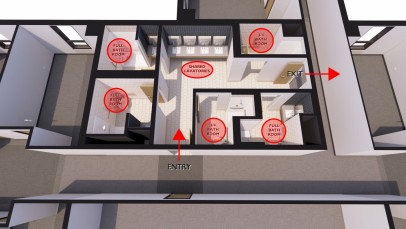As universities and colleges look to design new residence halls after the current global health crisis, they will be challenged with how to safely house students while still providing for their social and academic development. Social interactions have taken on a new normal – social distancing, limited-size gatherings, and a responsibility to act in a manner that does not make someone else sick. Residence hall design will evolve to reflect the current pandemic condition, say the student housing design experts at KWK Architects.
“Safety and security will be paramount for future students and their families, likely resulting in a desire for single-occupancy bedrooms in residence halls,” said KWK Architects Principal Sara Koester. “Single bedroom units can provide a safe haven – a personal retreat where students can relax away from others.”
She stresses, though, that this configuration may be too isolating for a student away from home for the first time. Many residence halls are designed specifically to house freshmen, and studies have shown that freshmen students in double bedrooms with a roommate have a higher rate of retention.
A “next best” bedroom design that will be considered is a double-bedroom designed as a “paired-single” unit – two singles side-by-side – with each occupant having furniture, a closet, operable window on “their side” and only necessarily shared elements, like a corridor door and mechanical unit/thermostat centrally located. The bedroom shape would be wide and shallow, allowing beds, desks and closets to be located further apart.
“The two sides can be marked with floor patterns and paint finishes to distinguish the two zones within the room,” said Koester. “The two roommates will function as a ‘family unit’ since they are indeed sharing a room. These resident students will have experienced the pandemic in their formative years and can rely on their prior experiences to understand the importance of appropriate space boundaries.”
New bathroom designs may favor a clustered single-use bath arrangement where private-use bathrooms - each containing a toilet, lavatory (sink) and shower - are located together. When grouped with a community lavatory area, this offers opportunities for socializing while still providing for privacy. Two entrance/exit points to the facilities will allow for a one-way traffic pattern to be implemented when environmental health conditions warrant. The common lavatory area, with ample space between fixtures, will allow for ease of hand washing as well as a chance to chat with other residents while maintaining social distancing. New staff training and procedures will be required to ensure a constant (or at least much more frequent) cleaning cycle to safeguard the safety of all building users.
Social spaces, such as floor lounges and studies, will be sized and organized to allow for social distancing with distinct “stations” at appropriate intervals. Areas can be demarcated with floor patterns.
“Kitchen facilities should ideally be arranged for one-way circulation and appliances spaced to permit multiple work areas with adequate buffers between. Hand washing stations should be ample and sufficiently spaced with accessories at each station,” said Koester. “It has always been important to provide a variety of social spaces that allow for a range of activities – quiet to active and small group to large group – but now residence halls should consider including single-person study spaces where a resident may go to focus on studies or simply decompress in a private, safe zone.”
Circulation spaces in residence halls will need to evolve. Entrances to buildings will need to be wider and feature multiple single entrance doors to avoid compressing residents as they enter the building. Lobbies should be large enough to allow for pedestrian flow to the elevators or stairs while social distancing, and elevators should be sized to accommodate multiple occupants at opposite corners. Additional elevators may be needed to safely address reduced elevator capacity due to social distancing restrictions. Corridors will need to be of ample width and preferably feature small alcoves at regular intervals off the main hallway, with views to the exterior and perhaps a bench, that can serve as places to “step out” of the way and not be in the traffic flow. Doors to bedrooms should be located in recessed pockets off the corridor allowing one to transition into the main corridor flow. Air flow exchange and mechanical systems may need to be reevaluated with more frequent filter changes.
“While the program for outdoor spaces in residence hall design has always been important, this will take on a heightened importance in providing places where residents can go for relaxation and space-distant socializing, with individual areas articulated in the design of the hardscape, landscape and outdoor furniture,” said Koester. “Individual outdoor activities, like hammocking and swings, can offer places to unwind, while outdoor terraces and patios can offer places for small groups to safely meet while social distancing.”
With careful and thoughtful planning, residence hall design can balance environmental health concerns and living preferences of students and their families while fostering community and providing a nurturing environment.





